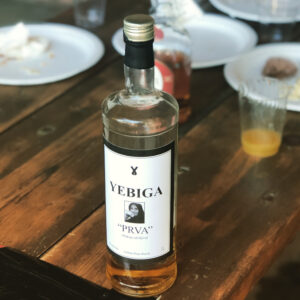Plum brandy, a.k.a. slivovitz or rakija, is not widely known in the United States. I have a vague childhood memory of someone gifting my father a bottle of plum brandy. And I loved the plum brandy offered at our local Chinese restaurant at the dessert course so much, the proprietor (R.I.P. Tom Shih) soon started pouring me my own small glass – with the approval of my parents, of course. After these many years, it is time for me – and you! – to update outdated notions of a spirit revered by my Czech ancestors and their neighbors.
What Is Slivovitz?

Rakija, the Serbo-Croatian name for sljivovica or slivovitz, is not a distilled spirit I had ever heard of. Perhaps it is because I grew up in a world where schnapps and grappa were the norm, handmade by my German and Swiss relatives, the similarly high alcohol, local alternative in regions southeast of the Danube River was utterly unknown. (I am half Czech on my mother’s side but my family lost all contact with that part of the family in the 1940’s.) Slivovitz – yes; rakija – no.
When I was offered the opportunity to sample rakija, now being imported into the United States by Bill Gould, the bassist of Faith No More fame, I envisioned a horizon-expanding opportunity. After all, that is exactly what happened after I learned to love locally-made brandy at California Brandy House. Brandy, after all, used to be the drink of choice for most Americans and can replace whiskey in many cocktails, including a Manhattan.
Rakija is the brandy of southeastern Europe, a region that stretches from the Czech Republic to Albania on the border of Greece and over to Turkey, where it is called raki. Though Gould began importing Yebiga Rakija, a specific brand of brandy, into the United States in 2019, sljivovica was fortuitously added to the U.N.’s list of “intangible cultural heritage as a cherished tradition to be preserved by humanity” in December of 2022.
And why not? Handcrafted from local plums and fermented using only local, wild yeasts, Yebiga’s rakija is double distilled in 500-liter batches (about 132 gallons) – a minuscule amount – before aging the spirit in local oak barrels. Like any small batch product, there is a fair amount of labor involved to produce rakija.
How Does It Taste?
Yebiga makes two brandies: young, unaged and feisty Bela and golden-hued Prva which is aged 18 months. Aromatically, Bela smells like late summer plums, fruity and mellow on the nose. Once it hits the palate, you notice its 40% abv but it translates as fresh and crisp with a spicy note and, on the mid-palate through the finish, vanilla. Unlike other homemade or nearly homemade alochol-forward spirits, it doesn’t burn with an intense heat. There is a softness here that I found pleasurable. I poured another glass.
Bela took home double gold in the 2021 San Francisco World Spirits Competition, a worthy honor for a smooth spirit.
Prva is an entirely different character. Plummy and floral on the nose, there are discernible phenolics from the oak barrel that translate to more pronounced spice and pine notes – a greater tongue tingle, if you will. The finish exhibits a classic burn that whiskey drinkers and others so enjoy. In a classic California God Rush cocktail, I would swap Prva rakija in for the bourbon. There is a freshness to it that makes the drink less cloying and more straightforward.

It’s Time to Rethink Brandy
As a whiskey and grappa fan, I enjoyed learning about rakija while conjuring up memories of friends and family. Updating my fusty image of slivovitz into something entirely more modern is a breath of fresh air both for my memory bank and my cocktail cabinet.
Rather than drinking these spirits straight, however, I would prefer to add them to a cocktail. Creating new memories is what savoring a cocktail with friends is all about. If you don’t slivovitz, now would be a good time to rethink that position.

